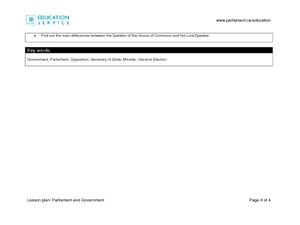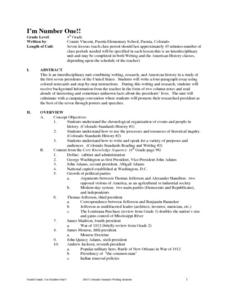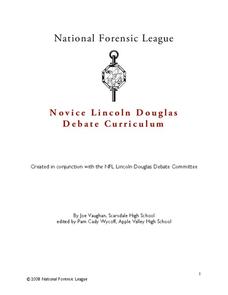Curated OER
South Africa After Ten Years of Freedom
Students see how events in South Africa have affected other areas of the world both through the use of economic sanctions and truth and reconciliation commissions. They analyze significance of this election in light of South Africa's...
Curated OER
We the People: 270 out of 538
Students engage in a instructional activity that helps them better explain the quadrennial ritual surrounding the election of a president in the United States of America.
Curated OER
Political Movements: Political parties
Young scholars list current federal parliamentary parties, consider the role of political parties, practice party based representation, state the relationship between parties, elections and Australian policy, and define specific...
Curated OER
Andrew Jackson and the Formation of Political Parties
Eighth graders explore the political election process. They identify how the system changed during the presidency of Andrew Jackson. Students use analogies and discussion, and answering questions to explore Jackson and his cabinet. ...
Curated OER
Worksheet 16: Plurality
In this plurality worksheet, students study a given set of voting statistical data. They use the plurality method to determine the election results. This two-page worksheet contains four multi-step problems.
Curated OER
Our Unfinished Work
Young scholars investigate the racism elements after the election of President Barack Obama. In this racism instructional activity, students read a recent article about 'post-racial' society. Young scholars compile a list of achieving a...
Curated OER
How Can Citizens Participate?
Middle schoolers are introduced to the notion of citizen participation. They analyze their own participation in the last school election, then read and discuss the definition of the term citizen.
Curated OER
Worksheet 14: Condorcet Method
In this Condorcet Method worksheet, students use the Condorcet and Borda Methods to determine the results of given election data. This two-page worksheet contains four multi-step problems.
Curated OER
Worksheet 15: Sequential & Hare Methods
In this Sequential and Hare Method worksheet, students determine the results of elections from given sets of information. They use either the Sequential or Hare Method to determine the outcome. Students justify their answers. This...
Curated OER
Extended Family
Students examine the 2004 European elections. In this current events lesson, students visit the noted Web sites to consider the pros and cons of expanding the European Union.
Curated OER
Jefferson Administration
Students research the major domestic issues that were present during the administration of Thomas Jefferson including the acquisition of the Louisiana Territory, Lewis and Clark's expedition, and his foreign policy. They investigate...
Curated OER
Elect Me! Creating a Campaign Platform and Video Commercial
Students conduct political campaigns. In this campaign investigation lesson, students research political parties and political offices. Students choose an office to run for and create election videos that incorporate propaganda techniques.
Curated OER
Parliament and Government
Students examine the roles of those in Parliament. In this British government lesson, students participate in a mock election and conduct research regarding the difference between Parliament and government.
Curated OER
I'm Number One!
Fourth graders complete a unit of lessons on the first seven presidents of the U.S. They conduct research, write a four-paragraph essay, and create posters and speeches for a simulated campaign convention.
Curated OER
Donkeys and Elephants and Voters, Oh My!
Students celebrate party politics. In this American politics lesson, students discover what the 2 main political parties in the country are and discuss their functions. Students then participate in a classroom simulation that requires...
Curated OER
Fighting Political Apathy Among Youth
Students research and describe youth participation in political elections. They survey random adults about their voting behavior and chart the results in a graph. They compile their results to predict future voter participation.
Curated OER
Election Day Cryptarithm
In this algebra instructional activity, students rewrite word problems using clues, into algebraic equations. They break the code deciding between political candidates John or Barack. There is an answer key to this problem.
Carolina K-12
Create a City!
What is the purpose of a city charter? What services do local governments provide to their citizens? Is there an ideal way for citizens to behave? Approach these often overlooked yet important questions with your class members by having...
iCivics
Power Play
Should states or the federal government have more power? With this fantastic online interactive, your pupils will be charged with the task of identifying arguments that support either federal or state power.
School Improvement in Maryland
Demographic Investigation
What are the factors that influence voting patterns? How do these factors influence government funding? Is participation the squeaky wheel gets the grease? Class members interpret graphs and analyze trends to determine what demographic...
Curated OER
Novice Lincoln Douglas Debate Curriculum
How do you affirm and negate a statement of value? What is refutation? Interested in debate? Introduce your class to the format of the Lincoln Douglas debate with 14 lessons, designed to be used in order, so that debaters learn the logic...
Museum of Tolerance
Influence of Media
We are bombarded with media images expressly designed to influence viewers. Learning how to analyze the intended effects of these images is essential and the focus of an activity that asks viewers to use the provided questions to guide...
C-SPAN
Presidential Birth Requirement
Every president of the United States must be a natural-born citizen, but the definition of natural-born is not as straightforward as it seems. Secondary scholars examine two points of view surrounding the constitutional requirement and...
National Constitution Center
Interactive Constitution
Did you know there are seven Articles and 27 Amendments to the US Constitution? Explore each and every one of them, including the Bill of Rights and other rights around the world, in a super neat US Constitution interactive.
Other popular searches
- Election Day
- Presidential Elections
- Election Day for Kids
- 2008 Presidential Election
- Voting and Elections
- Election of 1860
- Election 2008
- 2nd Grade Election Day
- Mock Election
- Election Day Activities K 3
- Abraham Lincoln Election
- 2008 Elections

























